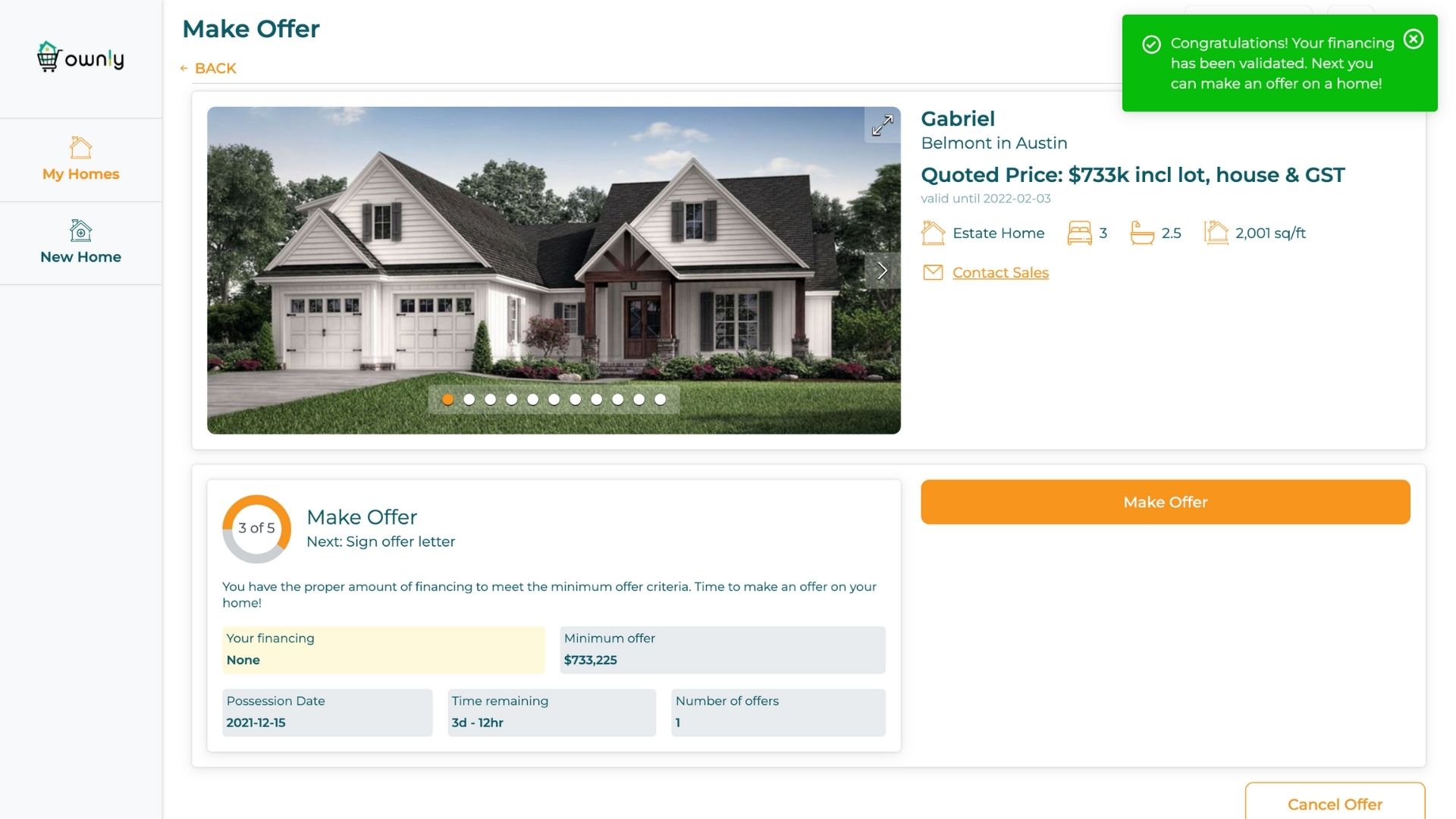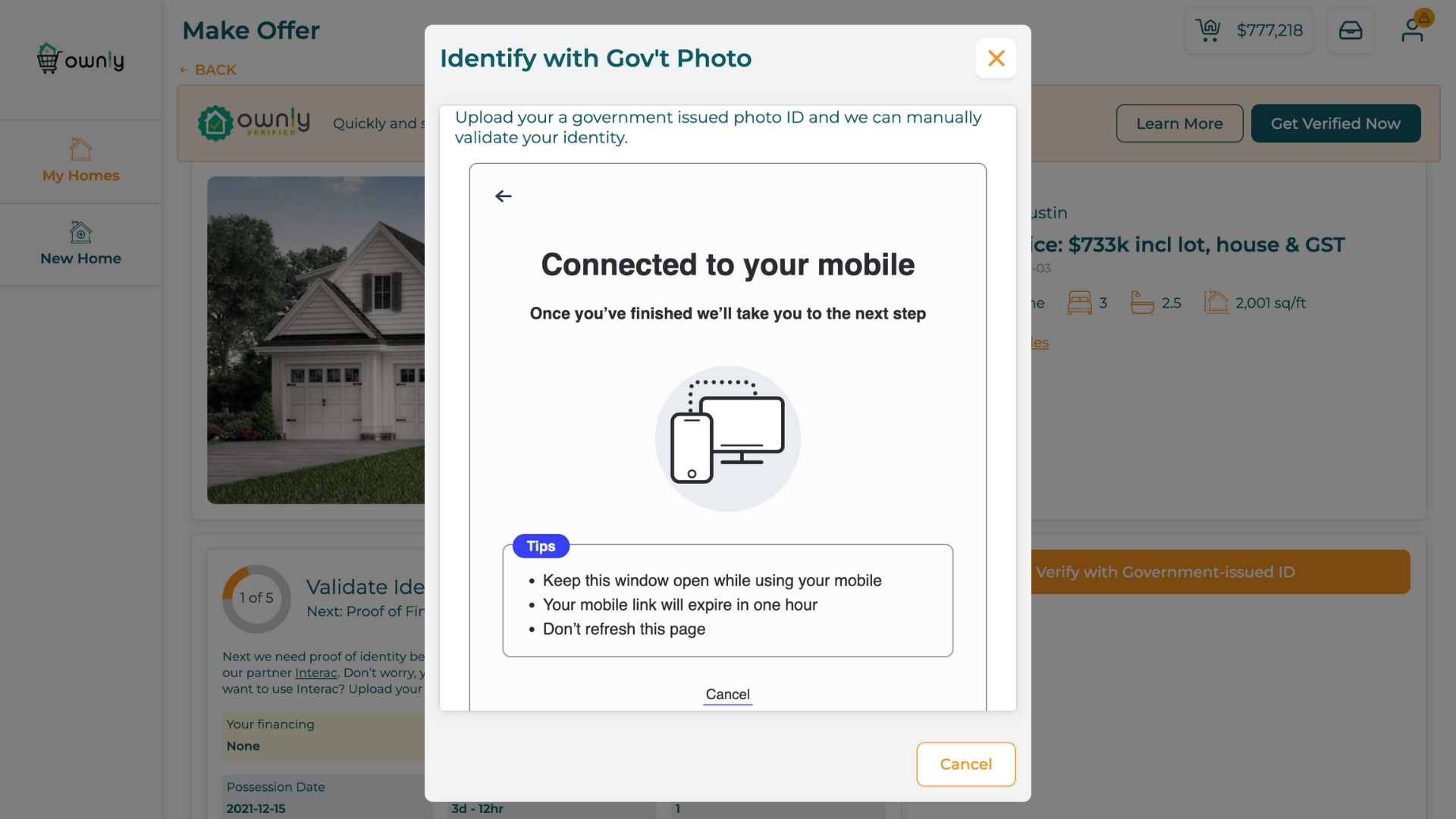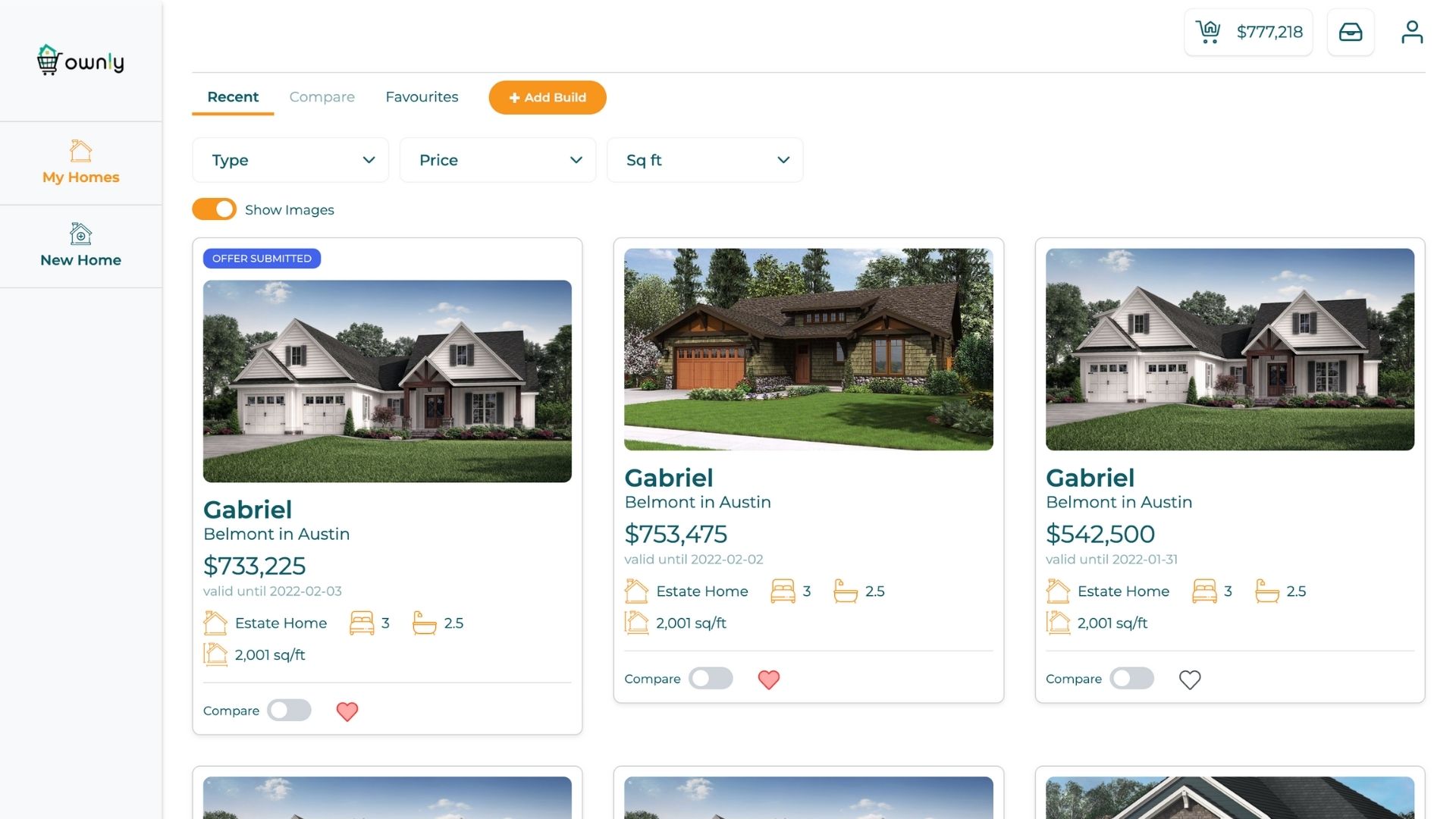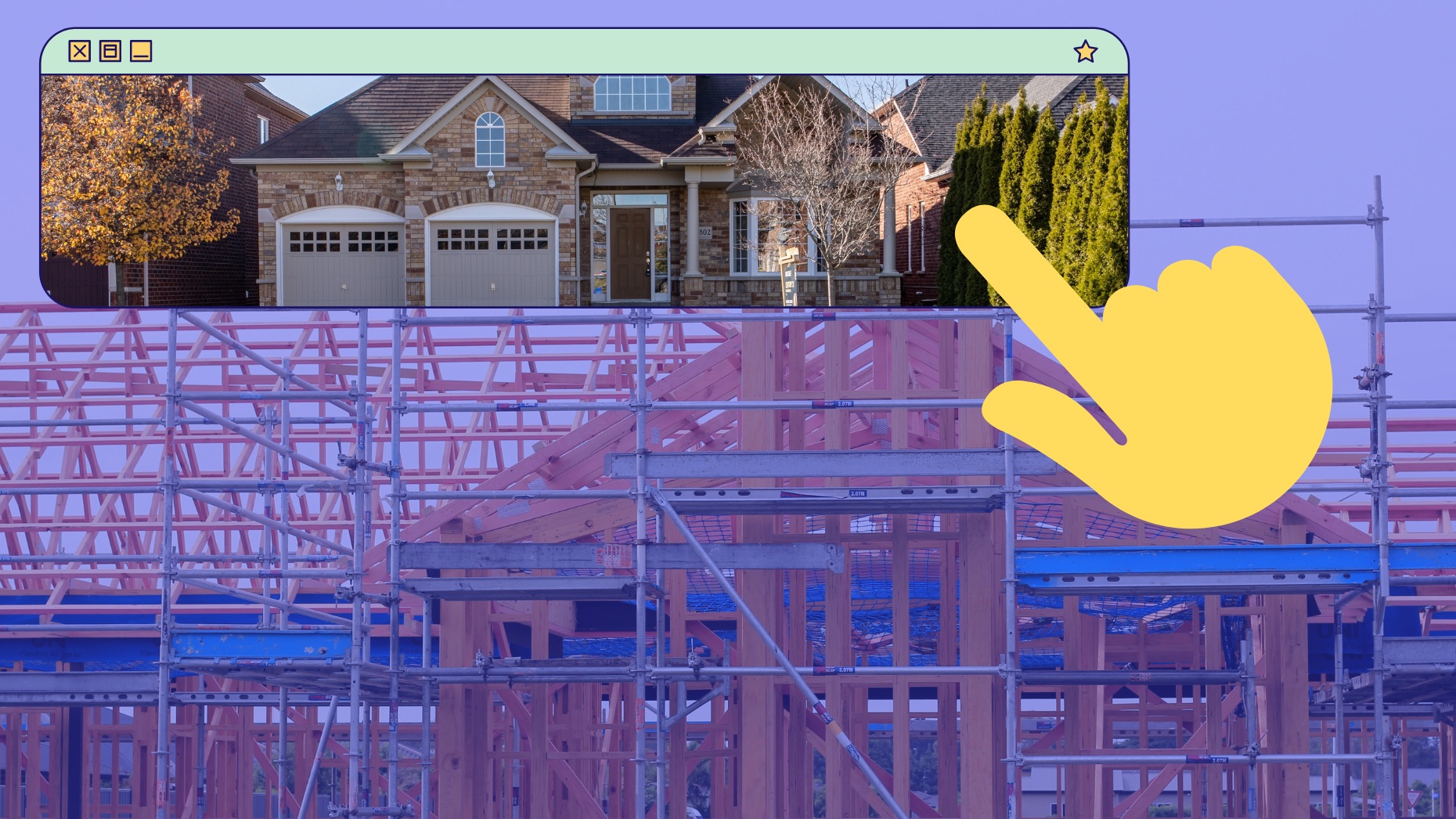Ownly is e-commerce software for home construction companies and new home buyers.
Platforms: Browser-based; mobile
Ideal for: Agents who work in new construction
Top selling points:
- Consumer retail experience
- Built-in mortgage qualification
- Couch-to-contract
- Builder website embeds
- Use of web-user metrics, shopping trends
Top concern:
After the shopping and contract experience is complete, buyers will need to rely on the builder’s existing project communication tactics, which could derail what was initially a very proactive, consumer-first process.
What you should know
Ownly is a SaaS (software as a service) company that provides home builders with a consumer-driven retail storefront from which aspiring buyers can shop for homes with a Netflix-inspired browsing experience, get pre-qualified for a mortgage, and sign an offer-to-purchase contract. Agents at the mercy of antiquated on-site builder sales tactics could benefit greatly from the on-ramp Ownly offers, as will the agents representing the buyers.
As is common when an entrepreneur tries to buy a home, they can’t stop spotting opportunities for improvement in the process.
I can see how this issue would arise more often when looking for new construction, given its host of timeline vagaries, thick catalogs, physical office visits and compendium of terms and construction steps foreign to anyone not actually in the construction business.
Fortunately for users of Ownly, its founder, Jason Hardy, comes from real estate development, and among other leadership roles, currently sits as executive director of the Real Estate Development Institute (REDI) an educational non-profit founded in 1972.
Before creating Ownly, Hardy wanted to know why buying a house couldn’t be like ordering a car online. Shoppers can choose a base model, add options, see imagery, consider financing and even now take delivery — all from their couch. While most new homes aren’t delivered on a flatbed, the industry had no real argument against Hardy’s position.
So, why not give home builders the tools they need to get people from couch-to-contract, as Hardy puts it?

Onwly gives developers a backend suite of tools to populate property information and publish it in the form of an online gallery of new homes. Controlling what the shopper sees is as easy as toggling off a few options and uploading images and content.
The consumer sees a clean, attractive page of property cards displaying the basics, such as price, size, beds and baths. They can browse builders’ community locations by zip or name, move sliders to adjust price and size specifications and if available, search by whatever interior home packages are offered.
Users can save properties in their My Homes folder, select a few to compare and begin the purchasing process by clicking a not-hard-to-miss “buy this home,” button.

The idea of reducing a home purchase to the words “buy this home” may seem overly simplistic, given the scale of the transaction, but remember, this is software designed to do exactly that — reduce the complexity of buying a home. We’re all trained by website calls to action, we love “buy now” buttons. Home shoppers are no different, and Ownly clearly recognizes that.
Buyers browse and select exterior finishes and interior layouts from interactive floorplans, which often include kitchen features, garage stall options, bedrooms, bathroom alternatives and the like. Ownly also allows for lot selection when available, too.
In short, if an option exists, Ownly’s flexibility ensures a builder can make it part of their store.
Once pushed into the buying steps, consumers can upload a prequalification letter or work with Ownly’s mortgage partner (undisclosed at this time) to get it underway. The software can handle everything needed, even face scans to confirm identification against an uploaded photo ID.

Upon prequalification and price acceptance, buyers and their agents can peruse pertinent documentation, sign what’s needed through DocuSign and even use a Stripe connection for deposits.
I was told by Hardy that a new partnership will soon be in place to make the actual purchase and closing experience fully digital, fast and compliant. It will leverage shared-video document signing, electronic transfer of funds and smooth municipal recording.
Again, this entire experience can be used from into the developer’s website, finally giving builders’ agents an excellent tool for collecting the countless number of leads that come to a builder’s site, get frustrated, and leave.
Ownly’s in-house study found that developers using its platform saw initial website visitors spend more than twelve minutes on their site, compared to well under two minutes without a storefront experience.
The software renders itself on mobile nicely as well, giving shoppers something else to browse instead of Zillow. Looking at other peoples’ homes can be fun, but how about asking your friends to help choose your bedroom layout?
Ownly is open and flexible, working with Hubspot and Salesforce as CRMs for now, but I was told more are on the way.
Hardy said they have three builders soon to launch in Florida and Texas. Ownly charges $499 per lead to the builder, but only when that lead is fully qualified. It also charges .5 percent of the transaction value.
With more people buying sight unseen and fighting to get offers accepted, buying new construction becomes a worthwhile consideration. Now imagine how much more attractive buying new becomes when builders actually meet the buyer halfway.
In 2021, I reviewed Welcome Homes, a home developer that offers its customers a sharp digital buying platform. I liked what I saw then, and it looks as if they’re only getting better at it. Now with Ownly in the mix, this niche of proptech has some solid shoulders on which to perch itself.
Have a technology product you would like to discuss? Email Craig Rowe
Craig C. Rowe started in commercial real estate at the dawn of the dot-com boom, helping an array of commercial real estate companies fortify their online presence and analyze internal software decisions. He now helps agents with technology decisions and marketing through reviewing software and tech for Inman.



 Are You Interested in West Eleventh Residences Miami?
Are You Interested in West Eleventh Residences Miami? Are You Interested in ONE Park Tower by Turnberry?
Are You Interested in ONE Park Tower by Turnberry? Are You Interested in Diesel Wynwood Condominium?
Are You Interested in Diesel Wynwood Condominium? Are You Interested in Five Park Miami Beach?
Are You Interested in Five Park Miami Beach? Are You Interested in Cipriani Residences Miami?
Are You Interested in Cipriani Residences Miami? Are You Interested in Bentley Residences Miami?
Are You Interested in Bentley Residences Miami? Are You Interested in Baccarat Residences Brickell?
Are You Interested in Baccarat Residences Brickell? Are You Interested in Aria Reserve Miami?
Are You Interested in Aria Reserve Miami? Are You Interested in 888 Brickell Dolce & Gabbana | Miami?
Are You Interested in 888 Brickell Dolce & Gabbana | Miami? Are You Interested in 600 Miami WorldCenter?
Are You Interested in 600 Miami WorldCenter? Are You Interested in HUB MIAMI RESIDENCES?
Are You Interested in HUB MIAMI RESIDENCES? Are You Interested in WALDORF ASTORIA RESIDENCES?
Are You Interested in WALDORF ASTORIA RESIDENCES?